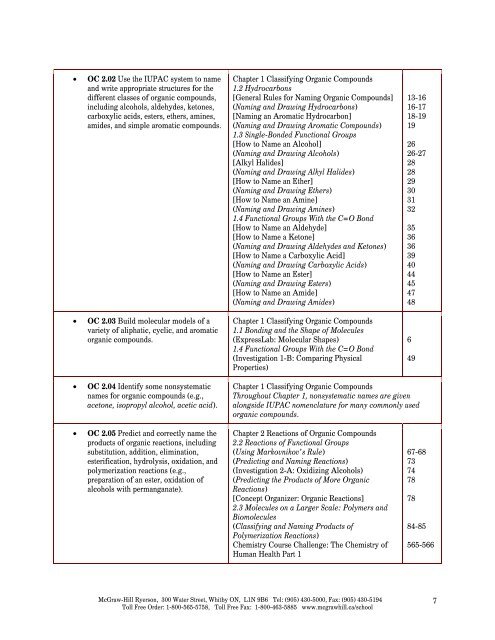McGraw-Hill Ryerson Chemistry 12 and
McGraw-Hill Ryerson Chemistry 12 and
McGraw-Hill Ryerson Chemistry 12 and
- No tags were found...
Create successful ePaper yourself
Turn your PDF publications into a flip-book with our unique Google optimized e-Paper software.
• OC 2.02 Use the IUPAC system to name<strong>and</strong> write appropriate structures for thedifferent classes of organic compounds,including alcohols, aldehydes, ketones,carboxylic acids, esters, ethers, amines,amides, <strong>and</strong> simple aromatic compounds.• OC 2.03 Build molecular models of avariety of aliphatic, cyclic, <strong>and</strong> aromaticorganic compounds.Chapter 1 Classifying Organic Compounds1.2 Hydrocarbons[General Rules for Naming Organic Compounds](Naming <strong>and</strong> Drawing Hydrocarbons)[Naming an Aromatic Hydrocarbon](Naming <strong>and</strong> Drawing Aromatic Compounds)1.3 Single-Bonded Functional Groups[How to Name an Alcohol](Naming <strong>and</strong> Drawing Alcohols)[Alkyl Halides](Naming <strong>and</strong> Drawing Alkyl Halides)[How to Name an Ether](Naming <strong>and</strong> Drawing Ethers)[How to Name an Amine](Naming <strong>and</strong> Drawing Amines)1.4 Functional Groups With the C=O Bond[How to Name an Aldehyde][How to Name a Ketone](Naming <strong>and</strong> Drawing Aldehydes <strong>and</strong> Ketones)[How to Name a Carboxylic Acid](Naming <strong>and</strong> Drawing Carboxylic Acids)[How to Name an Ester](Naming <strong>and</strong> Drawing Esters)[How to Name an Amide](Naming <strong>and</strong> Drawing Amides)Chapter 1 Classifying Organic Compounds1.1 Bonding <strong>and</strong> the Shape of Molecules(ExpressLab: Molecular Shapes)1.4 Functional Groups With the C=O Bond(Investigation 1-B: Comparing PhysicalProperties)13-1616-1718-19192626-27282829303132353636394044454748649• OC 2.04 Identify some nonsystematicnames for organic compounds (e.g.,acetone, isopropyl alcohol, acetic acid).Chapter 1 Classifying Organic CompoundsThroughout Chapter 1, nonsystematic names are givenalongside IUPAC nomenclature for many commonly usedorganic compounds.• OC 2.05 Predict <strong>and</strong> correctly name theproducts of organic reactions, includingsubstitution, addition, elimination,esterification, hydrolysis, oxidation, <strong>and</strong>polymerization reactions (e.g.,preparation of an ester, oxidation ofalcohols with permanganate).Chapter 2 Reactions of Organic Compounds2.2 Reactions of Functional Groups(Using Markovnikov’s Rule)(Predicting <strong>and</strong> Naming Reactions)(Investigation 2-A: Oxidizing Alcohols)(Predicting the Products of More OrganicReactions)[Concept Organizer: Organic Reactions]2.3 Molecules on a Larger Scale: Polymers <strong>and</strong>Biomolecules(Classifying <strong>and</strong> Naming Products ofPolymerization Reactions)<strong>Chemistry</strong> Course Challenge: The <strong>Chemistry</strong> ofHuman Health Part 167-687374787884-85565-566<strong>McGraw</strong>-<strong>Hill</strong> <strong>Ryerson</strong>, 300 Water Street, Whitby ON, L1N 9B6 Tel: (905) 430-5000, Fax: (905) 430-5194Toll Free Order: 1-800-565-5758, Toll Free Fax: 1-800-463-5885 www.mcgrawhill.ca/school7

















